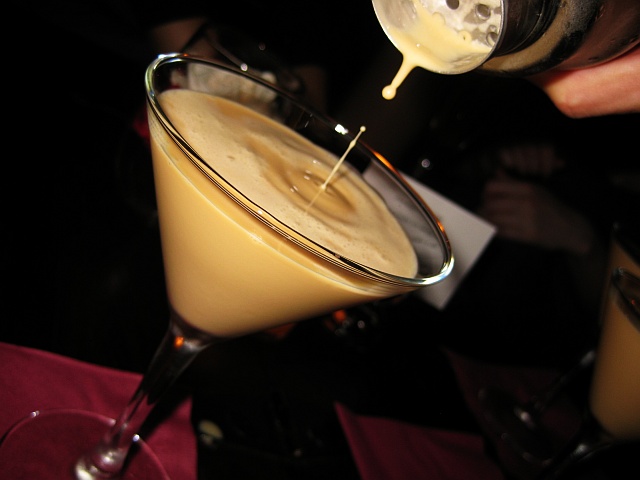In our family, any good milkshake calls for 1-2 tsp of vanilla extract, and we would use Mom's homemade stuff in our concoctions. When Katie was in elementary school, she was in the habit of making herself a milkshake every night after her gymnastics practice. For about a week straight, my parents couldn't figure out why Katie was so loopy and so sleepy each night after gymnastics. Then we discovered that she had a little trouble following recipes - instead of using a tsp of vanilla extract, Katie was throwing in a 1/4 cup or more. Turns out Katie was unintentionally spiking her milkshakes each night! And thus, I was both introduced to the joys of homemade infusions and tipsy eight-year-olds at the same time.
Infusions are a fantastic way to try new flavors and spice up old cocktails. All you need for this process are some mason jars, a good lemon zester, cheesecloth, patience and some creativity! Infusion is the process of adding flavor to neutral spirits (usually vodka, but you can also play with almost any liquor) by steeping fruits/berries/nuts/peppers/you name it in said spirits for several weeks at a time. The Art of Steeping has some great recommendations on how to prepare your various ingredients for infusion, but really the sky is the limit. Below are easy-to-follow recipes for two of my favorite infusions: Cranberry-Ginger Rum and Lemoncello, as well as some cocktail suggestions for each. I hope you enjoy both of these, but also feel free to experiment on your own (and let me know if you find anything good!)
Cranberry Ginger Rum
You will need: 1.5 cups cranberries, washed and with stems removed, 3-4 pieces of crystallized ginger, one 750 ml bottle of mid-grade silver rum (Appleton, Bacardi, etc), 0.5 cups sugar, cheesecloth
In a saucepan on medium heat, add cranberries and sugar with 2-4 oz of water. Stir until sugar is completely dissolved and cranberries have "popped" (when heated, the s.kin of the cranberries should burst in a cross-hatch pattern, so that each cranberry looks like a little hot cross bun). Remove from heat and place in large mason jar. Add 2 tbsp of crystallized ginger, chopped finely. Pour your bottle of rum over this and seal the mason jar tightly. Let the mixture sit for 5 days, shaking the mixture daily to prevent the ingredients from settling. Remove the cranberries from the mixture with a slotted spoon and strain the liquid back into a stoppered bottle or mason jar using a cheesecloth and funnel. Enjoy!
Spiced Ocean Spray Cocktail
Fill a highball glass with ice
Add 1.5 oz cranberry ginger rum

Top with lemon-lime soda
Stir mixture with bar spoon for 5-10 seconds
Garnish with 1/8 lime wedge
Cranberry-Ginger Mojito
In a highball glass, muddle 7-10 cranberries, 6 springs mint, 3-4 small lime wedges and (optionally) one slice of crystallized ginger with 1.5 ounces of simple syrup.
Add 1.5 oz cranberry ginger rum
Add ice to fill glass
Top with soda water
Stir vigorously with bar spoon for 5-10 seconds
Garnish with 1/8 lime wedge
Lemoncello
You will need: 6 large lemons, lemon zester, 750 ml bottle of mid-grade vodka (New Amsterdam, Svedka), distilled water, superfine sugar, cheesecloth
Zest your six lemons*, and place the peels in a large mason jar. Ensure that there is NO pith (the foamy white inner skin of the lemon) on your peels during the zesting process - failure to remove the pith will result in an extremely bitter, nearly undrinkable concoction. Pour your bottle of vodka over top of the lemon zest, seal your jar and let sit for 6-10 days, agitating daily. While you are waiting, prepare 750 ml of simple syrup using distilled water and the superfine sugar in a 1:1 ratio (don't remember how to make simple syrup? Here you go!). After 6-10 days, add 750 ml simple syrup** to the vodka-lemon zest mixture and re-seal your mason jar, allowing the vodka-syrup mix to steep for an additional 2-3 days. Filter the liquid 2-3 times using a cheesecloth and funnel to remove any free-floating particulates, then bottle and refrigerate. Enjoy!
*Note: You can go crazy with other citrus options as well. By far my favorite non-lemon option is Blood Orange. If you choose to go this route, zest 4 large blood oranges and add the juice of one of the oranges to the vodka/zest mixture to give it a little extra blood orange flavor.
**Note: Because you have added the simple syrup to your vodka mixture, the resulting proof of your liqueur will be half that of the vodka you began with. Most lemoncello is 40 proof (20% ABV). If you would like stronger lemoncello, use a stronger grain alcohol a you base, such as everclear.
Lemon Drop Martini
 The simplest way to make this little number is to combine 2 oz lemoncello with 1 oz vodka, shake the mixture over ice, strain and serve in a martini glass. If you prefer a slightly more tart martini (or less sweet), follow the instructions below:
The simplest way to make this little number is to combine 2 oz lemoncello with 1 oz vodka, shake the mixture over ice, strain and serve in a martini glass. If you prefer a slightly more tart martini (or less sweet), follow the instructions below:In a cocktail shaker, combine:
1 oz vodka
1 oz lemoncello
0.5 oz simple syrup
0.5 oz lemon juice
Run a lemon around the edge of a martini glass, and then rim the glass with sugar. Shake the ingredients, strain and serve in the sugar-rimmed glass. Garnish with a lemon zest (you can save the zest you used to make your lemoncello - the steeping process makes them boozy and a little chewy, but kind of a fun addition)


